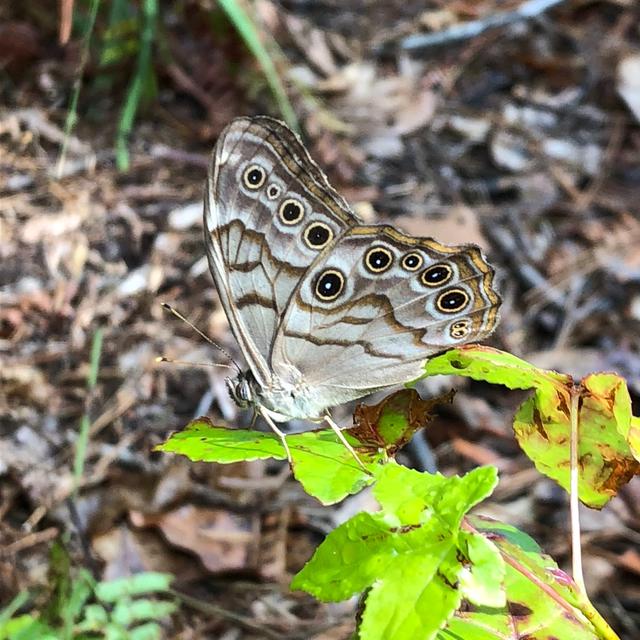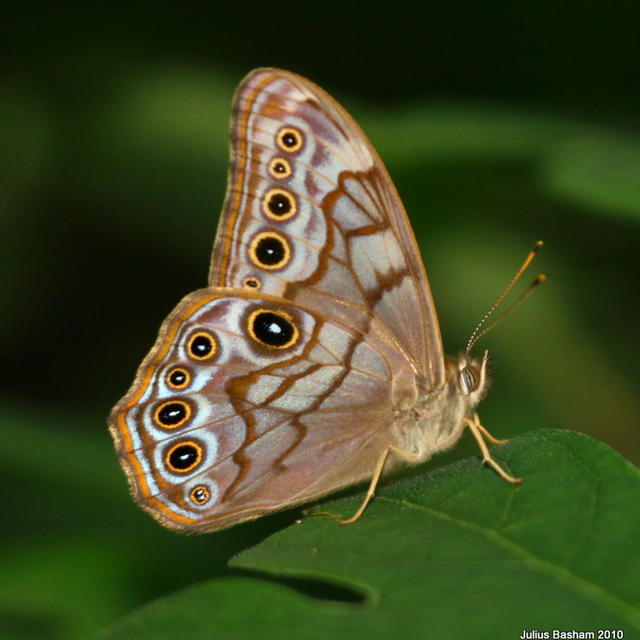Creole Pearly-eye
Enodia creola (Skinner, 1897)
Family: Nymphalidae
Subfamily: Satyrinae
Identification: Male forewing is pointed; upperside is brown with raised patches of dark scales along veins. Underside of both sexes is tan; forewing has a straight submarginal row of 5 spots; dark line along inner side of spot row arches outwardly at the cell.
Wing Span: 2 5/16 - 2 3/4 inches (5.9 - 7 cm).
Life History: Adults perch on tree trunks during the day, up to 10 feet above ground. Males perch and wait for females in late afternoon or on cloudy days. Females lay eggs singly on or near the host plants; caterpillars feed on leaves at night and hide at the base of the plant during the day. Caterpillars hibernate.
Flight: Two broods in the north from June-September, three broods in the south from April-September.
Caterpillar Hosts: Switch cane (Arundinaria tecta) in the grass family (Poaceae).
Adult Food: Rotting fruit, sap, dung, carrion; never flower nectar.
Habitat: Dense moist woods near large swamps, dense upland forests in the southern Appalachians.
Range: Southeastern states from North Carolina and central Georgia west to eastern Oklahoma and eastern Texas. Does not occur in southeast Alabama, southern Georgia, or Florida.
Conservation: Swamp forest habitats are gradually being encroached on, although several large preserves are extinct.
NCGR: G4 - Apparently secure globally, though it might be quite rare in parts of its range, especially at the periphery.
Management Needs: Conserve and minimally manage remaining habitats under secure land ownership.
Comments: NULL
Get your BAMONA Gear!
Please donate!
We depend on donations to keep Butterflies and Moths of North America freely available. We want to express our gratitude to all who showed their support by making a contribution this year. You can donate to support this project at any time.
Advertise with us!
Do you have a product or service that you think would interest BAMONA users? If you would like to advertise on this website, contact us by email, or use the contact form and select the "Advertising" category.
Verified Sightings
Displaying 25 - 48 of 492 verified sightings

Observation date: Aug 08, 2015
Submitted by: Dennis Forsythe
Region: Johnston County, North Carolina, United States
Verified by: Dennis Forsythe
Verified date: Dec 07, 2020

Observation date: Aug 08, 2015
Submitted by: Dennis Forsythe
Region: Johnston County, North Carolina, United States
Verified by: Dennis Forsythe
Verified date: Dec 06, 2020

Observation date: Jun 29, 2012
Submitted by: Roy Cohutta
Region: Dougherty County, Georgia, United States
Verified by: Mikelchap
Verified date: Sep 28, 2020

Observation date: Jun 29, 2012
Submitted by: Roy Cohutta
Region: Dougherty County, Georgia, United States
Verified by: Mikelchap
Verified date: Sep 28, 2020

Observation date: Apr 21, 2020
Submitted by: Dennis Forsythe
Region: Berkeley County, South Carolina, United States
Verified by: Dennis Forsythe
Verified date: May 18, 2020

Observation date: Sep 27, 2019
Submitted by: Jonathan Clark
Region: Catahoula Parish, Louisiana, United States
Verified by: stomlins701
Verified date: Feb 05, 2020

Observation date: Aug 03, 2019
Submitted by: Hans Holbrook
Region: Livingston Parish, Louisiana, United States
Verified by: John Calhoun
Verified date: Nov 19, 2019

Observation date: Sep 28, 2019
Submitted by: Rgilson
Region: Orangeburg County, South Carolina, United States
Verified by: Dennis Forsythe
Verified date: Oct 03, 2019

Observation date: Sep 28, 2019
Submitted by: ncrosbyrd
Region: Orangeburg County, South Carolina, United States
Verified by: Dennis Forsythe
Verified date: Sep 29, 2019

Observation date: Jul 30, 2017
Submitted by: Debo Boddiford
Region: Barnwell County, South Carolina, United States
Verified by: Dennis Forsythe
Verified date: Sep 11, 2019

Observation date: Jun 11, 2019
Submitted by: lmreid71
Region: Jefferson County, Alabama, United States
Verified by: stomlins701
Verified date: Aug 26, 2019

Observation date: Aug 03, 2019
Submitted by: Hans Holbrook
Region: Livingston Parish, Louisiana, United States
Verified by: stomlins701
Verified date: Aug 20, 2019

Observation date: Jul 20, 2019
Submitted by: Dennis Forsythe
Region: Oconee County, South Carolina, United States
Verified by: Dennis Forsythe
Verified date: Jul 31, 2019

Observation date: May 25, 2019
Submitted by: S. J. Stedman
Region: White County, Tennessee, United States
Verified by: dbruce
Verified date: Jun 06, 2019

Observation date: Jul 06, 2010
Submitted by: jrfleullan
Region: Bibb County, Georgia, United States
Verified by: Mikelchap
Verified date: May 26, 2019

Observation date: May 20, 2019
Submitted by: Smalltowngirl
Region: Hawkins County, Tennessee, United States
Verified by: dbruce
Verified date: May 22, 2019

Observation date: May 07, 2019
Submitted by: Jonathan Clark
Region: Catahoula Parish, Louisiana, United States
Verified by: stomlins701
Verified date: May 09, 2019

Observation date: May 07, 2019
Submitted by: Jonathan Clark
Region: Catahoula Parish, Louisiana, United States
Verified by: stomlins701
Verified date: May 09, 2019

Observation date: Aug 23, 2014
Submitted by: Dennis Forsythe
Region: Clarendon County, South Carolina, United States
Verified by: Dennis Forsythe
Verified date: Sep 10, 2018

Observation date: Aug 23, 2018
Submitted by: Dennis Forsythe
Region: Oconee County, South Carolina, United States
Verified by: Dennis Forsythe
Verified date: Sep 10, 2018

Observation date: Jul 22, 2018
Submitted by: MadameX
Region: Lancaster County, South Carolina, United States
Verified by: John Calhoun
Verified date: Jul 24, 2018

Observation date: Apr 27, 2018
Submitted by: Candler
Region: Coweta County, Georgia, United States
Verified by: Mikelchap
Verified date: Jun 20, 2018

Observation date: Jun 16, 2018
Submitted by: misspt
Region: Wilkinson County, Mississippi, United States
Verified by: stomlins701
Verified date: Jun 17, 2018

Observation date: Sep 09, 2017
Submitted by: Debo Boddiford
Region: Bulloch County, Georgia, United States
Verified by: Mikelchap
Verified date: Mar 12, 2018
- ‹ previous
- 2 of 21
- next ›





